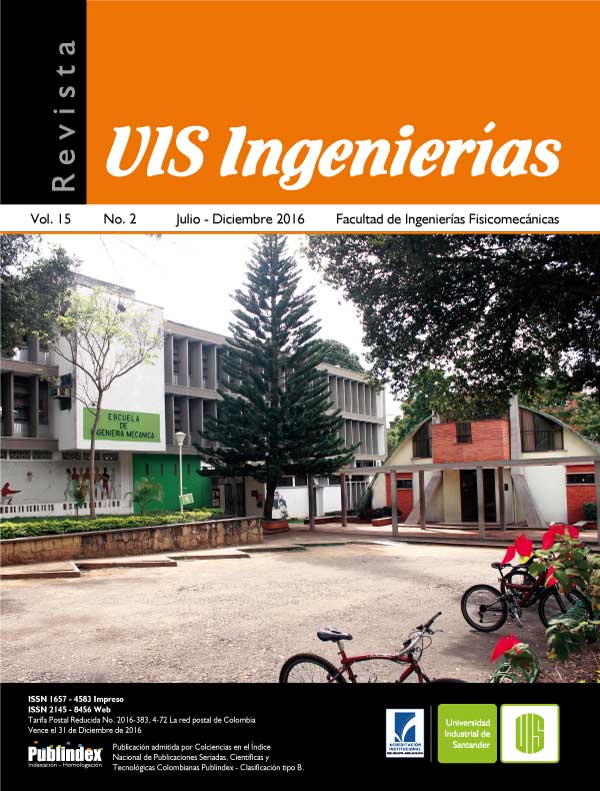Publicado 2016-06-15
Palabras clave
- Dinámica,
- movemaster RV-M1,
- robótica,
- solidWorks
Cómo citar
Resumen
Se presenta la aplicación del principio energético Lagrange-Euler para obtener el modelo matemático de la dinámica del robot Mitsubishi Movemaster RV-M1. La determinación de la ubicación de los centros de masa de cada eslabón y las matrices de inercia se realiza a partir de un modelo CAD generado con el software SolidWorks, en el cual se tuvieron en cuenta los elementos internos de cada eslabón con su material y ubicación. El modelo matemático se usa para calcular los torques requeridos en una estrategia de control de compensación por gravedad, y se compara el efecto de las propiedades obtenidas con SolidWorks en la respuesta del robot con aquella obtenida utilizando parámetros reportados en literatura existente. Se obtuvieron resultados satisfactorios en los errores del espacio de la tarea mediante este enfoque, no experimental pero detallado para determinar las propiedades dinámicas de un robot usando un software relativamente económico y disponible en las universidades colombianas.
Descargas
Referencias
- ADAMS MSC Software, Simulating Reality Delivering Certainty [web en línea] < http://www.mscsoftware.com/product/adams> [consulta: 4-9-2015].
- BONILLA, M.; PARRA, V. y RUIZ, F. Co-simulation of cooperative robots based on ADAMS, MATLAB and a haptic interface. Congreso anual de la Asociación de México de Control Automático, Ramos Arizpe, México, 6-8 de octubre de 2010.
- CEGARRA, J. Metodología de la investigación científica y tecnológica. Madrid: Ed. Díaz de Santos, 2004.
- CRAIG, J. Introduction to robotics: Mechanics and control. 2da ed. New York: Addison-Wesley-Longman, 1989.
- CRANE, C. and DUFFY, J. Kinematic analysis of robot manipulators. New York City: Ed. Cambridge, 1998.
- CRANE, C.; DUFFY, J. and CARNAHAN, T. A kinematic analysis of the space station remote manipulator system. Journal of Robotic Systems. 1991, vol. 8, num. 5, pp. 637-658.
- CRANE, C., DUFFY, J. and CARNAHAN, T. A kinematic analysis of the modified flight telerobotic servicer manipulator system. Journal of Robotic Systems. 1992, vol. 9, num. 3, pp. 461-480.
- DUFFY, J. and CRANE, C. A displacement analysis of the general spatial seven link, 7R mechanism. Mechanism and Machine Theory. 1980, vol. 15, pp. 153-169.
- DUFFY, J. and ROONEY, J. A foundation for a unified theory of analysis of spatial mechanisms. Journal of Engineering for Industry, Trans. ASME. 1975, vol. 97, num. 4, series B, pp. 1159-1164.
- HAMILTON, C. Using MATLAB to advance the robotics laboratory. Journal of Computer Applications in Engineering Education. 2007, vol. 15, num. 3, pp. 205-213.
- HERNÁNDEZ, R.; FERNÁNDEZ, C. y BAPTISTA, P. Metodología de la investigación. 5ta ed. Perú: Ed. McGraw Hill, 2010.
- JAZAR, R. Theory of applied Robotics: Kinematics, Dynamics and Controls. New York City: Ed. Springer, 2007.
- KELLY, R. y SANTIBAÑEZ, R. Control de Movimiento de robots manipuladores. Madrid: Prentice Hall, 2003.
- KUMAR, R.; KALRA, P. and PRAKASH, N. A virtual RV-M1 robot system. Journal of Robotics and Computer-Integrated Manufacturing. 2011, num. 27, pp. 994-100.
- Mitsubishi Electric Corporation. Industrial micro-robot system user manual, modelRV-M1. Naguya: Mitsubishi Corporation, 1992.
- ROLDÁN, J.; SOSA, J.; YIME, E. y DÍAZ, J. Cinemática inversa matricial del manipulador 5R Mitsubishi Movemaster RV-M1. Revista Épsilon. 2012, núm. 19, Julio-Diciembre, pp. 33-56.
- TAKEGAKI, M. and ARIMOTO, S. A new feedback method for dynamic control of manipulators. Trans. of ASME, Journal of Dynamic Systems, Measurement and Control. 1981, vol. 103, pp. 119-125.
- TSAI, L. Robots analysis: The mechanics of serial and parallel manipulators. New York City: Ed. Wiley Interscience, 1999.

